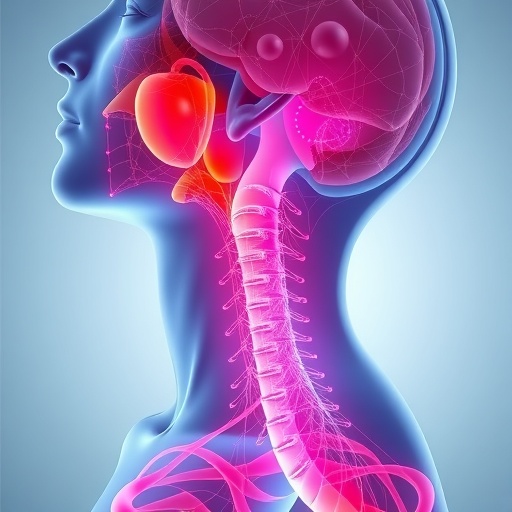A groundbreaking study has unveiled a novel, non-invasive method to enhance cerebrospinal fluid (CSF) drainage by mechanically stimulating the skin overlying superficial cervical lymphatic vessels (scLVs). This emerging technique holds promising implications for addressing CSF drainage impairments associated with aging and neurological disorders. The research pioneers a force-regulated mechanical stimulator designed to target lymphatic vessels in the face and neck, revealing a remarkable capacity to double CSF outflow through accessible lymphatic pathways.
The study centers on two specific superficial cervical lymphatic vessels, scLV-1 and scLV-2, selected due to their proximity to the skin’s surface and their unique innervation patterns. Unlike the deeper dorsal cervical lymphatics (dcLVs), these vessels present an accessible target for non-invasive manipulation. Notably, these lymphatics feature smooth muscle cells encased by adrenergic sympathetic nerves, identified via tyrosine hydroxylase staining, distinct from cholinergic parasympathetic innervation. This sympathetic regulation likely plays a crucial role in modulating lymphatic function in the head and neck regions.
To investigate whether CSF drainage could be augmented through intact skin, the researchers crafted a mechanical device capable of applying precisely controlled downward strokes at varying force magnitudes. Low-magnitude forces ranged from 0.01 to 0.02 kilogram-force (kgf), while high-magnitude forces reached 0.04 to 0.08 kgf. These stimuli were administered in carefully delineated regions: from the periorbital area to the mandible, from the nasal sidewall to the mandible, and along the trajectory of scLV-1 and scLV-2 towards the submandibular lymph node. Each session involved cyclic application of strokes directed at these regions, interspersed with rest periods.
The efficacy of this approach was validated using TMR–dextran, a fluorescent tracer infused intracisternally to track CSF movement. Following 5 minutes of low-magnitude mechanical stimulation, tracer accumulation in scLV-1 and scLV-2 more than doubled, exhibiting a 2.29-fold average increase in fluorescence intensity relative to controls. Conversely, high-magnitude stimulation produced vessel constriction and dramatically diminished tracer uptake by 89%, underscoring the critical importance of force modulation in optimizing lymphatic function.
Expanding upon these findings, the researchers extended mechanical stimulation to a longer duration—20 one-minute sessions—and assessed tracer transit from the subarachnoid space (SAS) to the submandibular lymph node. The result was a striking tripling (3.01-fold increase) of tracer fluorescence in the ipsilateral lymph node following low-force stimulation, with no comparable changes observed contralaterally. High-force stimulation again suppressed tracer accumulation, highlighting a biphasic response dependent on mechanical load.
Importantly, to distinguish whether observed effects reflected enhanced CSF clearance or merely mechanical displacement of lymph within the vessels, the team injected TMR–dextran directly into a lateral ventricle, combining this with low-magnitude stimulation. Subsequent measures of CSF removal at the cisterna magna revealed a significant 23% decrease in tracer concentration associated with stimulation, providing compelling evidence of true augmented CSF clearance from the SAS rather than passive lymphatic flushing.
Real-time intravital imaging further elucidated the temporal dynamics of lymphatic tracer uptake post-stimulation. Fluorescence intensity in the superficial cervical lymphatics more than doubled within one minute of a single low-magnitude stimulation session and remained elevated over a five-minute observation window. Notably, mechanical forces elicited modest dilation of the lymphatic vessels and a transient surge in spontaneous contraction amplitude. However, basal contraction frequency, ejection fraction, and overall fractional pump flow remained unchanged, suggesting stimulation primarily enhances vessel capacity without disrupting intrinsic contractile rhythms.
Addressing potential concerns regarding desensitization, repeated daily low-magnitude mechanical stimulation over four days neither altered contraction parameters nor diminished stimulation efficacy. This indicates a sustainable therapeutic window in which mechanical modulation can reliably amplify CSF drainage without adverse effects on lymphatic physiology, supporting the feasibility of translational application.
Mechanistic insights were gleaned through pharmacological inhibition of nitric oxide (NO) synthesis using N(ω)-nitro-L-arginine methyl ester (L-NAME). Administration of L-NAME decreased vessel diameter, contraction amplitude, ejection fraction, and fractional pump flow in scLV-1, affirming NO’s pivotal role in lymphatic spontaneous contractility. Moreover, NO blockade attenuated the augmentation of CSF drainage following mechanical stimulation by approximately 31%, underscoring NO signaling as a key modulator of lymphatic responsiveness.
The translational potential of the approach was bolstered by application in aged mice exhibiting baseline CSF drainage deficits (approximately 30% lower than young adults). Mechanical stimulation induced substantial increases in tracer accumulation: a 2.81-fold rise at the submandibular lymph node after 20 minutes of low-magnitude stimulation and a 4.7-fold elevation within scLV-1 and scLV-2 after 5 minutes. These magnitudes closely paralleled those observed in younger animals, effectively counteracting age-related drainage impairments.
Collectively, these results confirm that precisely calibrated, non-invasive mechanical stimulation of superficial cervical lymphatics can substantially enhance CSF outflow and lymphatic clearance, even in aged organisms. The specificity of low-magnitude forces and the involvement of adrenergic innervation and nitric oxide signaling provide mechanistic depth, while sustainability and efficacy in aging highlight clinical promise.
This innovative strategy invites exciting prospects for ameliorating neurological conditions linked to compromised CSF clearance, such as neurodegenerative diseases, hydrocephalus, or traumatic brain injury. By leveraging accessible superficial lymphatic pathways through gentle, controlled skin manipulation, new therapeutic modalities could emerge that circumvent invasive interventions and tap into the body’s intrinsic drainage systems.
Future studies may delve deeper into optimized stimulation parameters, long-term effects, and the interplay between lymphatic contractility and neural regulation. The clear demonstration of functional lymphatic modulation bridges mechanobiology and clinical neuroscience, positioning this work at the vanguard of neurovascular and lymphatic research.
As we stand at the threshold of harnessing the skin’s superficial lymphatics to mediate brain fluid homeostasis, this landmark study reframes our understanding of lymphatic network accessibility and control. It offers not only a novel scientific framework but also a hopeful path toward non-pharmacological strategies to mitigate age-related and pathological declines in CSF clearance.
Subject of Research: Non-invasive mechanical stimulation of superficial cervical lymphatics to enhance cerebrospinal fluid drainage.
Article Title: Increased CSF drainage by non-invasive manipulation of cervical lymphatics.
Article References:
Jin, H., Yoon, JH., Hong, S.P. et al. Increased CSF drainage by non-invasive manipulation of cervical lymphatics. Nature (2025). https://doi.org/10.1038/s41586-025-09052-5
Image Credits: AI Generated




